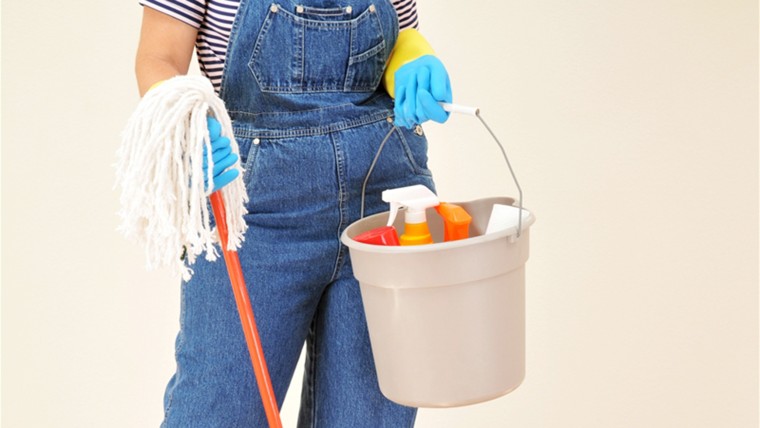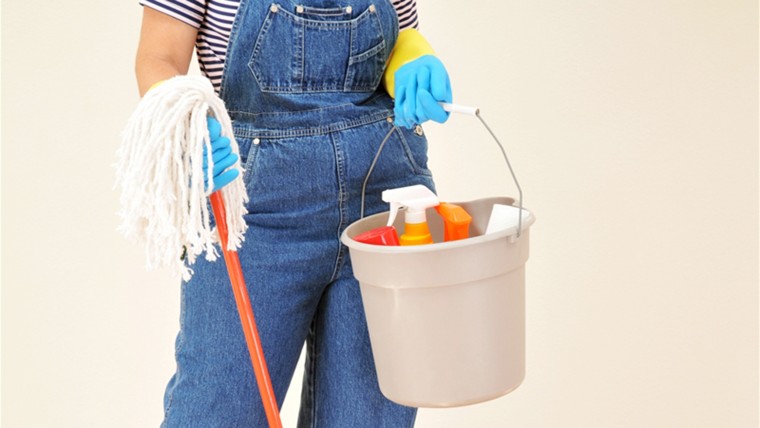
With warmer weather slowly settling in, it's time to say goodbye to those grimy windows and mud-stained floors. But before you grab the rubber gloves and cleaning spray to tackle spring cleaning duties, check out these tips from the experts.
Smartphone screens
That cloth that comes with a new pair of glasses isn't just great for eyewear, but can be used to clean smudges from your cell phone’s screen, suggests Luis Brea, a mobile electronics repair specialist at the mobile phone shop 1800fix.com. For extra cleaning power, apply a puff of LCD screen-cleaning spray to the cloth and wipe it along the screen, making sure to avoid the phone speaker. “A tiny drop of hand sanitizer on the cloth also works,” Brea adds.
Laminate floors
To tackle extra-stubborn messes on laminate flooring, wipe surfaces with a mixture of one cup of white vinegar and one gallon of warm water, said Meg Roberts, president of Molly Maid. Make sure to change the water as it gets dirty. For best results, dry with a clean, dry microfiber mop, though you can let a barely damp floor air dry. For shinier floors, buff with a dry towel.
Automatic coffee makers
You don’t need a special solution to de-gunk the coffee maker, says Leslie Reichert, author of "The Joy of Green Cleaning" and a housekeeping expert. She suggests mixing one part vinegar with two parts water and running the mixture through a brewing cycle. “If your coffee maker has a permanent filter or a water filter, remove these first," Reichert advises.
Run two cycles of plain water through the coffee maker after using the vinegar and water solution, letting the appliance cool between each cycle. Repeat monthly to keep germs at bay, according to the NSF.
Microwave
Take this simple, nontoxic approach from Reichert for cleaning the microwave. Mix a half cup of water with a half cup of lemon juice in a microwave-safe bowl. Microwave on high until the mixture comes to a rolling boil and the microwave window steams up. Let it cool for a few minutes, then wipe down the microwave's interior with a damp sponge. As for the exterior, Cheryl Luptowski of the NSF recommends wiping the keypad weekly with a disinfectant wipe or a clean cloth that is lightly dampened with warm, soapy water.
Windows, glass and mirrors
“For sparkling clean windows and glass, simply wet a microfiber cloth with water and wipe down the glass, then use a second, dry microfiber cloth to dry the window,” Reichert says. For heavier cleaning, wet a microfiber cloth with a solution of one part white vinegar to three parts water and a drop of dish soap.
It also helps if to time your cleaning just right. “When washing windows, wait for a cloudy day or start on the shady side of the house,” advises Carolyn Forte, director of the Home Appliances and Cleaning Products Lab at the Good Housekeeping Research Institute. “Washing windows in direct sunlight will cause the cleaner to dry too quickly and you'll be left with streaks that are hard to remove.”
Stove-top iron burner grates
Stove burner grates are usually tough to clean, but Reichert has a tip to make the job much easier. Place one cup of white vinegar into a large Ziploc bag. Sprinkle baking soda over the grate and submerge into the bag. Place the Ziploc in a pan overnight and wipe the grate clean in the morning.
Cast-iron pots and pans
Forget the soap. Cast iron cookware is porous, so the surface will absorb soaps it comes in contact with. “All you need to clean a cast-iron skillet is plain water and a sponge,” says John Besh, acclaimed chef, restaurateur and author. For burned-on residue, he suggests scrubbing with a stiff brush or boiling water and baking soda in the pan. Just be sure to dry it thoroughly to prevent rust, and rub the inside with a bit of canola oil to preserve the pan’s seasoning.
Rugs and carpets
Do you vacuum your entire house daily? You might be overworking yourself. According to carpet industry expert Charlie Rollins, it’s more effective to vacuum high-traffic areas once or twice a day than to vacuum the entire house once, especially if the other rooms are lightly used. In fact, unused rooms may only need vacuuming once a week. Rollins also recommends using door mats to stop dirt at the door. They can reduce wear on the carpet and lighten your cleaning load.
Pillows
Most think cleaning pillow cases makes is enough, but considering all the sweat and skin cells that pillows collect, they need a good cleaning two or three times a year. Start by checking the label to make sure the pillow can be machine washed. If it can, squeeze the excess air out of the pillow before placing it in the washer. (For top-loading washers, launder two pillows at a time to keep the load level. Front-load models can handle one or two pillows.) Use a fragrance-free detergent and, if needed, add a half cup of baking soda to the wash to help remove pillow odors. Run a full cycle using warm water, followed by an extra spin cycle to remove excess moisture. Dry on low using dryer balls. (You can make your own by tying a tennis ball in a white sock.)
At the end of the cycle, inhale deeply into the pillow. If it seems to contain moisture, put it through another dryer cycle. “This last part is very important,” Luptowski says. “Mold and mildew thrive in dark, damp environments. If you don’t thoroughly dry your pillows, mold can build up, which is a particular concern for those with respiratory problems or compromised immune systems.”
A version of this article originally appeared on iVillage.
